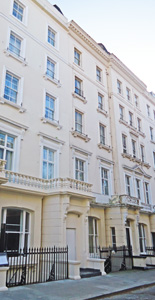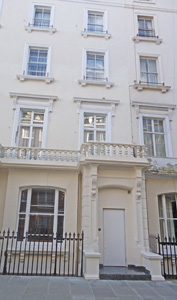Father Murphy Institute
for Inebriates
for Inebriates
49 Norfolk Square, Paddington, W2 1RX
Medical
dates:
Medical
character:
Rehabilitation (inebriates)
Fr Lawrence William Murphy, a Catholic priest in Buffalo, New York, had
devoted himself to the study of the pathology of inebriety. He
developed a formula based on the German system of gold salts therapy
(see below) and adapted it for use in the treatment of neurasthenia
caused by chronic drunkenness. The formula was modified for the
treatment of morphine and tobacco addiction.
In 1893 Fr Murphy had opened the first Father Murphy Gold Cure Institute in Montreal, where inebriates could be treated with 'Father Murphy's Gold Cure'.
However, the medical profession was sceptical about such 'gold' treatment and, in 1894, Fr Murphy was fined $50 for illegally practising medicine. (Apparently, the nominal physician appointed to the Institute had made only one visit and given one injection to each of the patients; thereafter the injections had been given by Fr Murphy himself.)
Despite this setback the Institute flourished and others opened in towns and cities of Canada and the eastern United States.
The Father Murphy Institute for Inebriates opened in London in March 1904 for the treatment of male and female inebriates by The Father Murphy Gold Cure, which had been used successfully in the Dominion of Canada over the past 12 years.
The purpose of the Gold Cure was to eradicate all desire for alcohol and to restore the nervous system to normal. Treatment was usually of three weeks duration and was two-fold: radical and tonic. Patients were given a liquid cordial to drink every two hours and received four hypodermic injections into the arm daily - at 8 o'clock, 12 noon, 5 o'clock and 7 o'clock. They were expected to be punctual for these. In between treatments, patients were free to come and go as they wished. Bathing was considered essential and patients were instructed to bathe at least twice a week.
Female patients were under the care of a Lady Superintendent.
The Institute in Norfolk Square was of a high class character. It was bright and cheerful with home-like surroundings where patients could relax. It had a piano and a Billiard Room.
However, it was only in operation for a few years.
By 1909 the building had been taken over by Miss Jean Hastie, the proprietor of the Mental Nurses' Co-operation.
In 1893 Fr Murphy had opened the first Father Murphy Gold Cure Institute in Montreal, where inebriates could be treated with 'Father Murphy's Gold Cure'.
However, the medical profession was sceptical about such 'gold' treatment and, in 1894, Fr Murphy was fined $50 for illegally practising medicine. (Apparently, the nominal physician appointed to the Institute had made only one visit and given one injection to each of the patients; thereafter the injections had been given by Fr Murphy himself.)
Despite this setback the Institute flourished and others opened in towns and cities of Canada and the eastern United States.
The Father Murphy Institute for Inebriates opened in London in March 1904 for the treatment of male and female inebriates by The Father Murphy Gold Cure, which had been used successfully in the Dominion of Canada over the past 12 years.
The purpose of the Gold Cure was to eradicate all desire for alcohol and to restore the nervous system to normal. Treatment was usually of three weeks duration and was two-fold: radical and tonic. Patients were given a liquid cordial to drink every two hours and received four hypodermic injections into the arm daily - at 8 o'clock, 12 noon, 5 o'clock and 7 o'clock. They were expected to be punctual for these. In between treatments, patients were free to come and go as they wished. Bathing was considered essential and patients were instructed to bathe at least twice a week.
Female patients were under the care of a Lady Superintendent.
The Institute in Norfolk Square was of a high class character. It was bright and cheerful with home-like surroundings where patients could relax. It had a piano and a Billiard Room.
However, it was only in operation for a few years.
By 1909 the building had been taken over by Miss Jean Hastie, the proprietor of the Mental Nurses' Co-operation.
Present status (February 2016)
The building was Grade II listed in 1975.
The door to No. 49 is now boarded-up and it is unclear whether it is part of the Camelot Hotel.


The boarded-up doorway of No. 49 Norfok Square.
The Gold Cure treatment
During the late 19th century public drunkenness had become a major social problem in the towns and cities of North America. Temperance movements began to be established; their supporters believed that alcohol was the cause of poverty due to unemployment, violence, crimes, family failure and sickness.
Earlier in the century salts of gold had been adapted by German physicians for the treatment of various nervous disorders. Around the same time, the Russian government had become alarmed ay the prevalence and increase of drunkenness among the officers of the army. It directed the Chief of the Medical Staff, Dr Dabronravoff, to find a remedy. He too experimented with salts of gold as a treatment for inebriation - with 'wonderful success'. Curing alcoholics became a serious business and several doctors in America began their own experiments. All claimed to be the discoverers of a successful gold cure formula.
Dr Leslie E. Keeley was one of the most successful American physicians. In 1879 he opened his first Keeley Institute in Dwight, Illinois. It was the first medical institution to treat alcoholism as a disease rather than a moral failure. By the 1890s there was a Keeley Institute in every state.
On entering the Institute, the patient was physically examined to exclude organic disease. The Keeley Cure then began, with injections four times a day, a liquid medicine to drink and baths.
Keeley never revealed what was in his Gold Cure, but analysts found it contained no gold. 'Bichloride of gold' was a technical misnomer (pharmacology does not recognise such a substance), as Keeley himself later admitted. He maintained that patients found it easier to have a simple name for their club, instead of the 'Chloride of Gold and Sodium Club'.
A 95% success rate was claimed by all those who provided a Gold Cure treatment.
In England, patients continued to be treated with a similar regime during the first decade of the 20th century. The injections contained a solution of daturine sulphate or atropine and strychnine sulphate, depending on the patient's condition. Liquid medicine was given every two hours and contained - variously - chloride of gold and sodium, ammonium chloride, aloin, fluid extract of viburnum and tincture of cinchona.
On the third or fourth day, the desire for alcohol was completely removed and the patient was unable to taste it or smell it, in many cases, without severe nausea or vomiting, thus developing a negative association with the substance. If a patient persisted in drinking after the fourth or fifth day, a little liquid extract of ipecacuanha was added to the medicine.
The third part of the treatment was hydrotherapy - full sheet packs, liver packs, vapour baths, sitz baths and spinal baths were all found to be beneficial.
The regime was expected to take from three to four weeks to provide a cure, although some patients required five or, very occasionally, six to eight weeks.
During the late 19th century public drunkenness had become a major social problem in the towns and cities of North America. Temperance movements began to be established; their supporters believed that alcohol was the cause of poverty due to unemployment, violence, crimes, family failure and sickness.
Earlier in the century salts of gold had been adapted by German physicians for the treatment of various nervous disorders. Around the same time, the Russian government had become alarmed ay the prevalence and increase of drunkenness among the officers of the army. It directed the Chief of the Medical Staff, Dr Dabronravoff, to find a remedy. He too experimented with salts of gold as a treatment for inebriation - with 'wonderful success'. Curing alcoholics became a serious business and several doctors in America began their own experiments. All claimed to be the discoverers of a successful gold cure formula.
Dr Leslie E. Keeley was one of the most successful American physicians. In 1879 he opened his first Keeley Institute in Dwight, Illinois. It was the first medical institution to treat alcoholism as a disease rather than a moral failure. By the 1890s there was a Keeley Institute in every state.
On entering the Institute, the patient was physically examined to exclude organic disease. The Keeley Cure then began, with injections four times a day, a liquid medicine to drink and baths.
Keeley never revealed what was in his Gold Cure, but analysts found it contained no gold. 'Bichloride of gold' was a technical misnomer (pharmacology does not recognise such a substance), as Keeley himself later admitted. He maintained that patients found it easier to have a simple name for their club, instead of the 'Chloride of Gold and Sodium Club'.
A 95% success rate was claimed by all those who provided a Gold Cure treatment.
In England, patients continued to be treated with a similar regime during the first decade of the 20th century. The injections contained a solution of daturine sulphate or atropine and strychnine sulphate, depending on the patient's condition. Liquid medicine was given every two hours and contained - variously - chloride of gold and sodium, ammonium chloride, aloin, fluid extract of viburnum and tincture of cinchona.
On the third or fourth day, the desire for alcohol was completely removed and the patient was unable to taste it or smell it, in many cases, without severe nausea or vomiting, thus developing a negative association with the substance. If a patient persisted in drinking after the fourth or fifth day, a little liquid extract of ipecacuanha was added to the medicine.
The third part of the treatment was hydrotherapy - full sheet packs, liver packs, vapour baths, sitz baths and spinal baths were all found to be beneficial.
The regime was expected to take from three to four weeks to provide a cure, although some patients required five or, very occasionally, six to eight weeks.
References (Accessed 21st February 2016)
(Author unstated) 1892 The Keeley "gold cure" for inebriety. British Medical Journal 2 (1645), 85-86.
(Author unstated) 1892 The so-called gold treatment of inebriety. British Medical Journal 2 (1646), 145.
Fenn SB 1904 The so-called "gold cure" of inebriety. British Medical Journal 1 (2261), 1008-1009.
Hare F 1906 The medical treatment of inebriety. British Journal of Inebriety 3, 196-201.
Keeley LE 1892 "The Gold Cure" (letter). British Medical Journal 2 (1644), 48-49.
Keeley LE 1892 The so-called "gold cure" of inebriety (letter). British Medical Journal 1 (1647), 182.
Lender ME, Martin JK 1987 Drinking in America. New York, The Free Press.
Morgan HW 1994 Drugs in America: A Social History, 1800-1980. Syracuse University Press.
http://addiction-dirkh.blogspot.co.uk
http://library.ndsu.edu
www.blairhistory.com
www.bottlebooks.com
(Author unstated) 1893 Interesting lecture on the gold cure. Quebec Saturday Budget, 25th March, 4.
(Author unstated) 1894 Doings in Montreal. Judgment involving the rights of gold cure institutes. Toronto Daily Mail, 25th April, 6.
(Author unstated) 1896 Father Murphy on Bryan. Evening Telegraph, 23rd October, 3,
(Author unstated) ? 1896 The Father Murphy Gold Cure Institute. Unknown publisher.
(Author unstated) 1896 The Father Murphy Gold Cure. Unknown publisher.
(Author unstated) (? 1904) The Father Murphy Institute for Inebriates: an efficacious and permanent cure for drunkenness, morphia and kindred habits, endorsed and endowed by the governments of Quebec and Nova Scotia (Canada). Pamphlet filed in the Wellcome Library, London.
Baumohl J 1993 Inebriate institutions in North America, 1840-1920. In: Warsh CLK (ed) Drink in Canada: Historical Essays. Montreal, McGill-Queens University Press. Pp 92-114.
http://collections.banq.qc.ca
www.britishlistedbuildings.co.uk
Return to home page